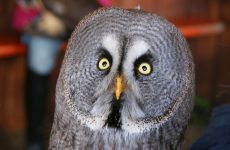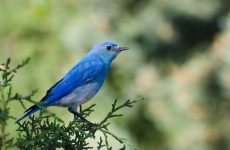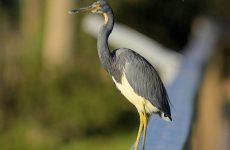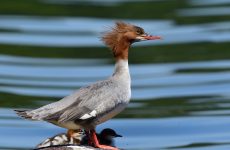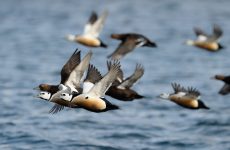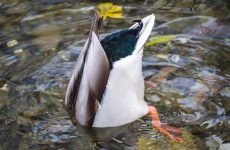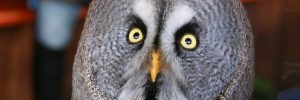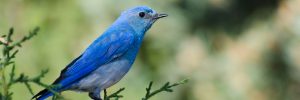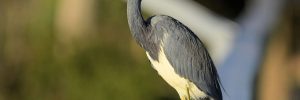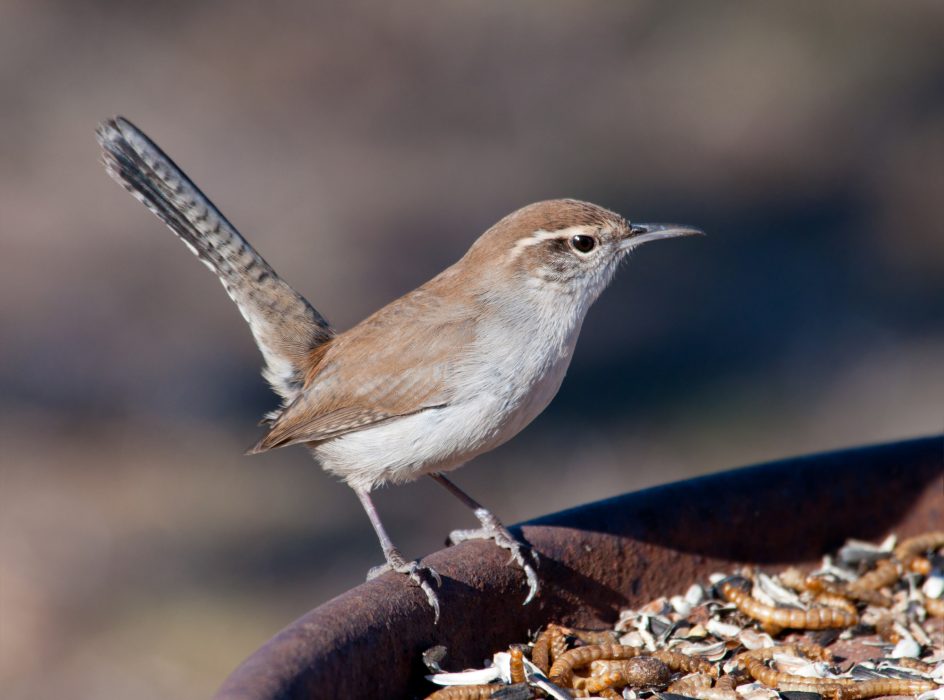
Brown birds can be hard to identify as they do not always have as many distinguishing features as their brighter colored cousins. But fear, not this guide will help you tell the difference between a sparrow and a wren.
This guide will help you identify those brown birds visiting your backyard or out in the woods and fields and is based on the 33 most common birds spotted in the United States and Canada.
These birds are listed in the frequency that they are spotted on checklists submitted by bird watchers on Ebird.
33 Brown Birds in North America
1. Mourning Dove
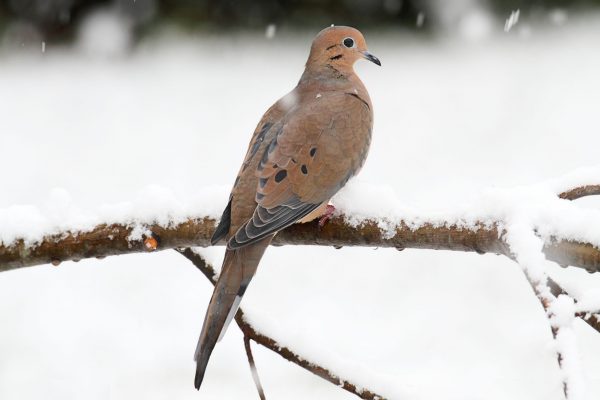
Mourning Doves are graceful small-headed birds, plump bodies and long tails. They are a soft brown with black spots on the wings. Males are slightly heavier than females.
- Length: 9.1-13.4 in (23-34 cm)
- Weight: 3.0 -6.0 oz (96-170 g)
- Wingspan: 17.7 in (45 cm)
Mourning Doves are common over all of the lower 48 all year but may migrate after breeding from the far north.
Mourning Doves can be seen perching on telephone wires and foraging for seeds on the ground in grasslands, fields, and backyards. They can also be found in open areas or on woodland edge.
You can attract more Mourning Doves to your backyard by scattering millet on the ground or on platform feeders. They will also eat black sunflower seeds, nyjer, cracked corn, and peanut hearts.
2. American Robin
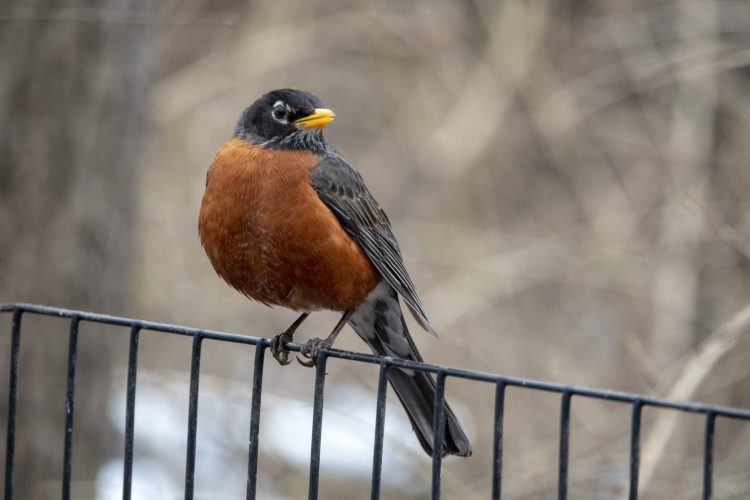
American Robins are a common sight on lawns eating earthworms. They have black heads and back with red or orange breasts. They tend to roost in trees in winter, so you are more likely to see them in your backyard from spring.
- Length: 7.9-11.0 in (20-28 cm)
- Weight: 2.7-3.0 oz (77-85 g)
- Wingspan: 12.2-15.8 in (31-40 cm)
American Robis are resident in the lower 48 and the coast of Western Canada and Alaska. Those that breed in Canada and inland Alaska move south for the winter.
American Robins can be found in many habitats, from woodlands, forests, mountains to fields, parks, and lawns. They eat earthworms, insects, snails, and fruit.
You can attract more American Robins to your yard with sunflower seeds, suet and peanut hearts, fruit, and mealworms. Platform feeders are best or food scattered on the ground. Also, try planting some native plants that produce berries such as juniper, sumac, hawthorn, and dogwood.
3. Song Sparrow
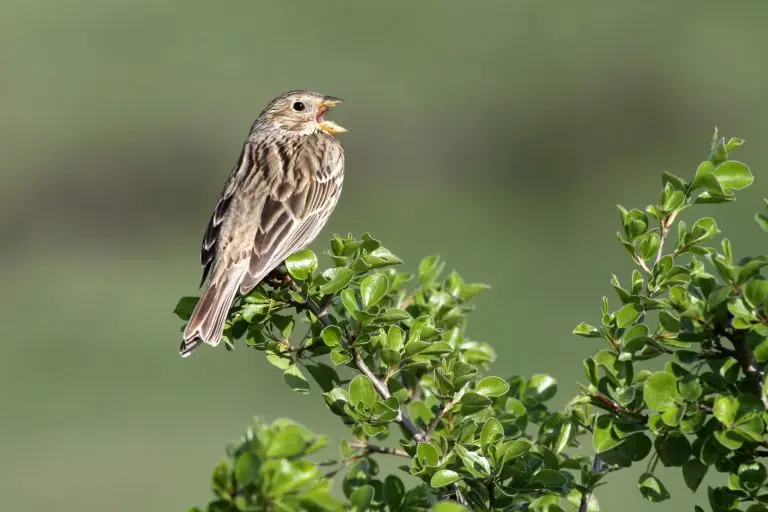
Song sparrows are not as remarkable as other backyard birds, but these small brown-streaked birds use their almost constant song to attract mates in spring and summer.
- Length: 4.7-6.7 in (12-17 cm)
- Weight: 0.4-1.9 oz (12-53 g)
- Wingspan: 7.1-9.4 in (18-24 cm)
Song Sparrow live all year in the northern US. Some breed in Canada and then migrate to southern states.
They can be found in open, shrubby, and wet areas, often perched on a low shrub singing. They are usually found at backyard feeders.
Song Sparrows eat a wide variety of insects and plants, including beetles, caterpillars, midges, spiders, and earthworms. They will also eat buckwheat, sunflower, raspberries, wild cherries, blackberries, wheat, and rice.
You can attract more song sparrows to your backyard feeders by putting black oil sunflower seeds, cracked corn, and nyjer on platform feeders.
4. Female House Finch
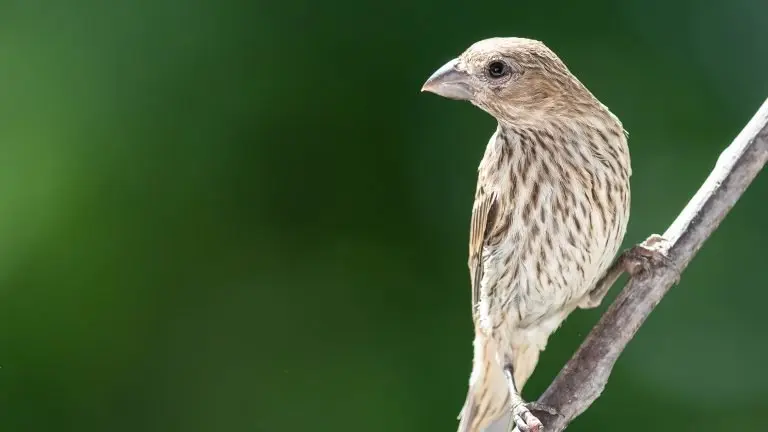
House Finches males have a red head and breast, but the females are brown-streaked small birds.
- Length: 5.1-5.5 in (13-14 cm)
- Weight: 0.6-0.9 oz (16-27 g)
- Wingspan: 7.9-9.8 in (20-25 cm)
Originally only in western states, House Finches were introduced to the eastern states and have done very well, even pushing out the Purple Finch.
They can be found in parks, farms, forest edges, and backyard feeders. They can be found in noisy groups that are hard to miss.
You can attract more House Finches to backyard feeders with black oil sunflower seeds or nyjer seeds in tube feeders or platform feeders.
5. Northern Flicker
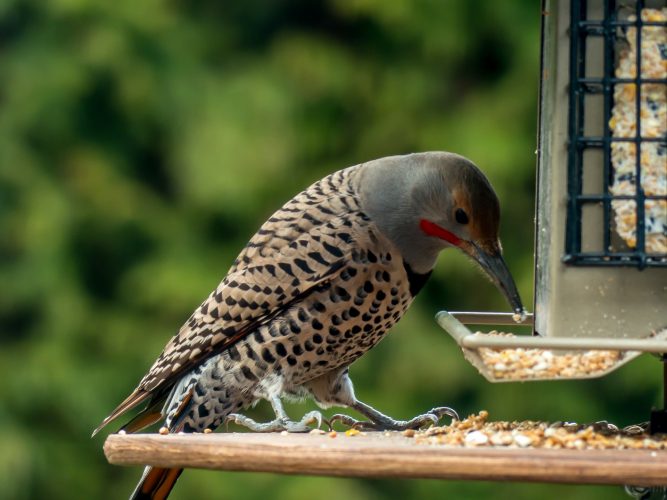
Northern Flickers are large woodpeckers, between the size of a robin and a crow, with brownish coloring and black spots, bars, and crescents and red on the nape. The undersides of tail and wing feathers are bright yellow in eastern birds and red in western birds.
- Length: 11.0-12.2 in (28-31 cm)
- Weight: 3.9-5.6 oz (110-160 g)
- Wingspan: 16.5-20.1 in (42-51 cm)
They can be found on the ground looking for ants and beetles in woods or forest edges. Those that breed in Canada or Alaska migrate to southern states, but otherwise, they can be found all year over the lower 48.
You can attract more Northern Flickers to your backyard feeders with suet and black oil sunflower seeds.
6. Carolina Wren
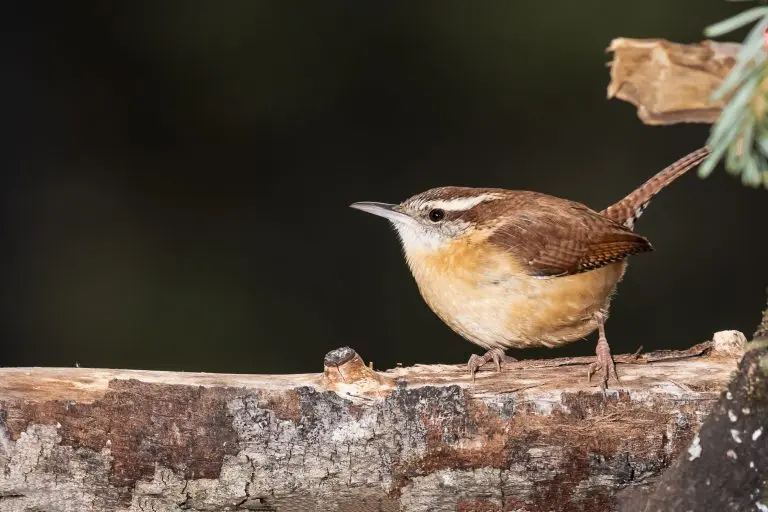
Carolina Wrens are shy birds that are dark brown on top and light brown underneath. They have a white eyebrow stripe and upright tail, and loud teakettle song.
- Length: 4.7-5.5 in (12-14 cm)
- Weight: 0.6-0.8 oz (18-22 g)
- Wingspan: 11.4 in (29 cm)
Carolina Wrens are residents all year across Eastern and Southeastern States.
They can be found in woods or thickly vegetated areas and visit backyard feeders.
You can attract more Carolina Wrens to your backyard feeders with suet feeders, hulled sunflower seeds, or peanut hearts in large tube feeders or on platform feeders.
7. White-throated Sparrow
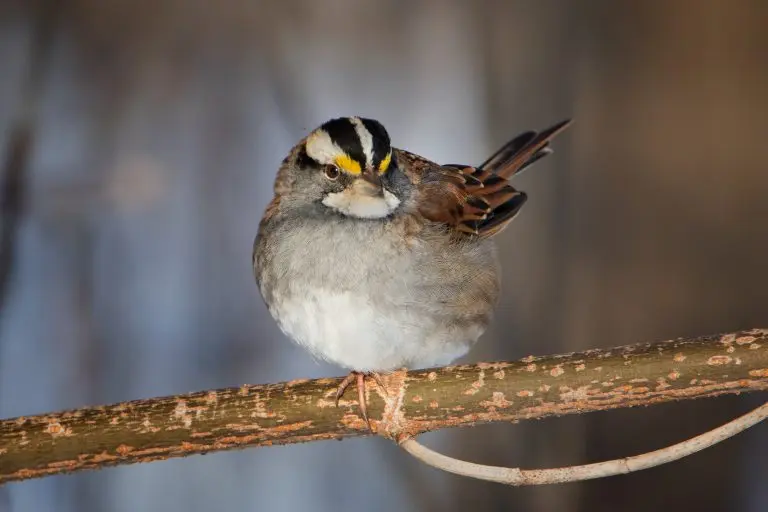
White-throated Sparrows have a distinctive black and white striped head, bright white throat, and yellow between the eye and bill. Their backs are brown, and underneath is gray.
- Length: 6.3-7.1 in (16-18 cm)
- Weight: 0.8-1.1 oz (22-32 g)
- Wingspan: 7.9-9.1 in (20-23 cm)
White-throated Sparrows are migratory birds, breeding mainly in Canada before heading south in winter to Eastern and Southern states and the Pacific Coast.
You can find White-throated Sparrows on the ground in forests and woods and along the edges of wooded areas, often in large flocks.
White-throated Sparrows diet is mainly seeds of grasses and weeds as well as fruits such as grape, sumac, mountain ash, blueberry, blackberry, and dogwood. They will also eat a large number of insects from the forest floor, especially in summer.
You can attract White-throated Sparrows to your backyard feeders with millet and black oil sunflower seeds on platform feeders.
Check out these articles if you want to know more about birds in North America:
8. Chipping Sparrow
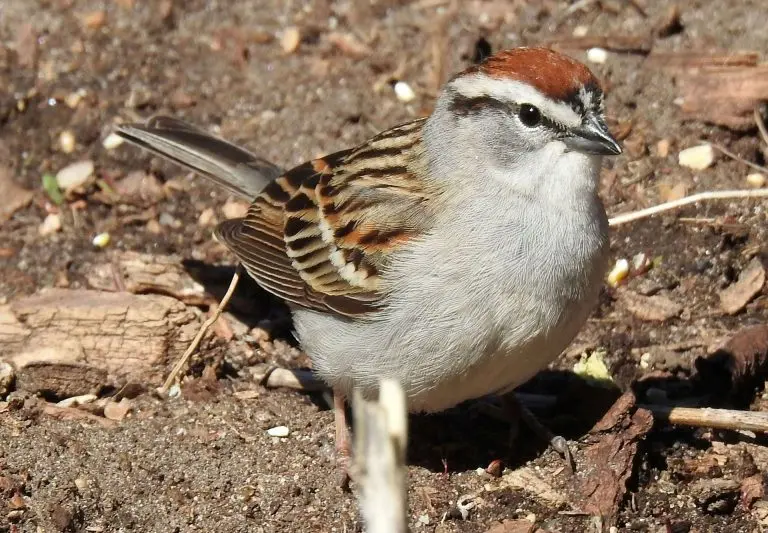
Chipping Sparrows are slender, long-tailed birds that have a grayish belly and brown bracks that are black-streaked, with a rusty crown and black eye line. In winter, the colors are more subdued.
- Length: 4.7-5.9 in (12-15 cm)
- Weight: 0.4-0.6 oz (11-16 g)
- Wingspan: 8.3 in (21 cm)
Chipping Sparrows spend their summer breeding over much of North America and Canada before flying to Mexico and Florida for winter. Some remain all year in the Southern States.
They can be found in small flocks on open ground and come to backyards for many kinds of birdseed.
9. Female Brown-headed Cowbird
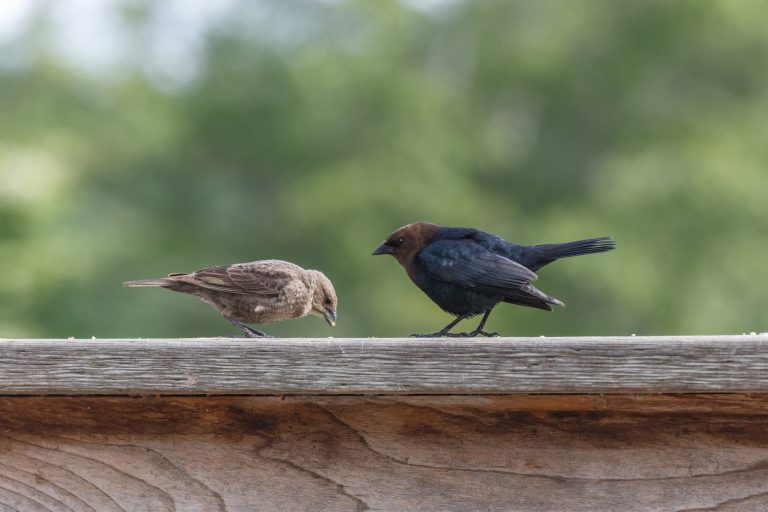
Female Brown-headed Cowbirds are brown all over with slight streaking.
Males are larger and black-bodied with brown heads and with short tails.
- Length: 76.3-8.7 in (19-22 cm)
- Weight: 1.3-1.8 oz (42-50 g)
- Wingspan: 14.2 in (36 cm)
Brown-headed Cowbirds breed in much of the north and west of North America before heading further south but remain all year in the Eastern and Southern states and Pacific Coast.
They are often considered a nuisance as they destroy the eggs of smaller songbirds so that they can lay their eggs in the nest and have the bird foster their chicks.
10. Common Yellowthroat
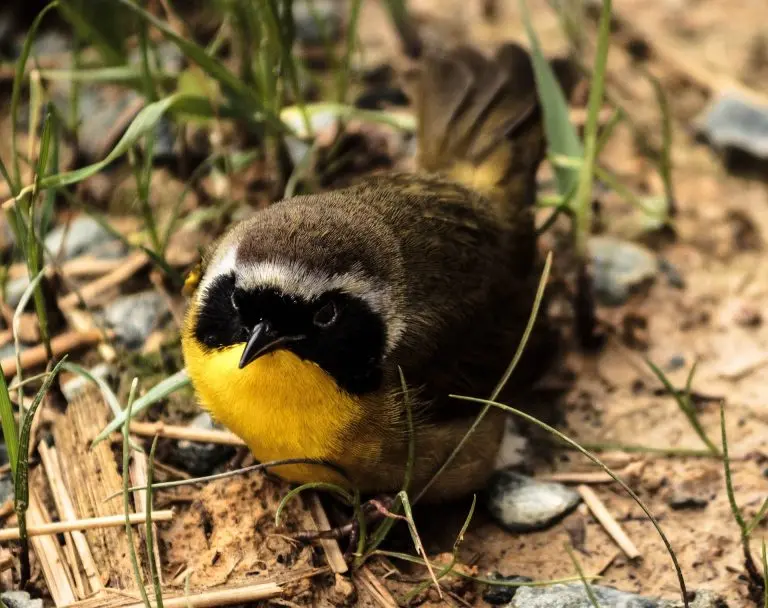
Common Yellowthroats are small brown songbirds that are bright yellow underneath, with long tails. The males have a black mask across their face. The brightness of the yellow can vary geographically, and they may be more olive in parts underneath.
- Length: 4.3-5.1 in (11-13 cm)
- Weight: 0.3-0.3 oz (9-10 g)
- Wingspan: 5.9-7.5 in (15-19 cm)
Common Yellowthroats spend the summer breeding over most of North America, except Alaska and northern Canada. Some remain all year along the Gulf Coast and Pacific Southwest.
They can be found in the spring and summer, often in marshy or wetland areas and brushy fields living in thick, tangled vegetation.
They eat mostly insects and will be found in large backyards that have dense vegetation.
11. Eastern Phoebe
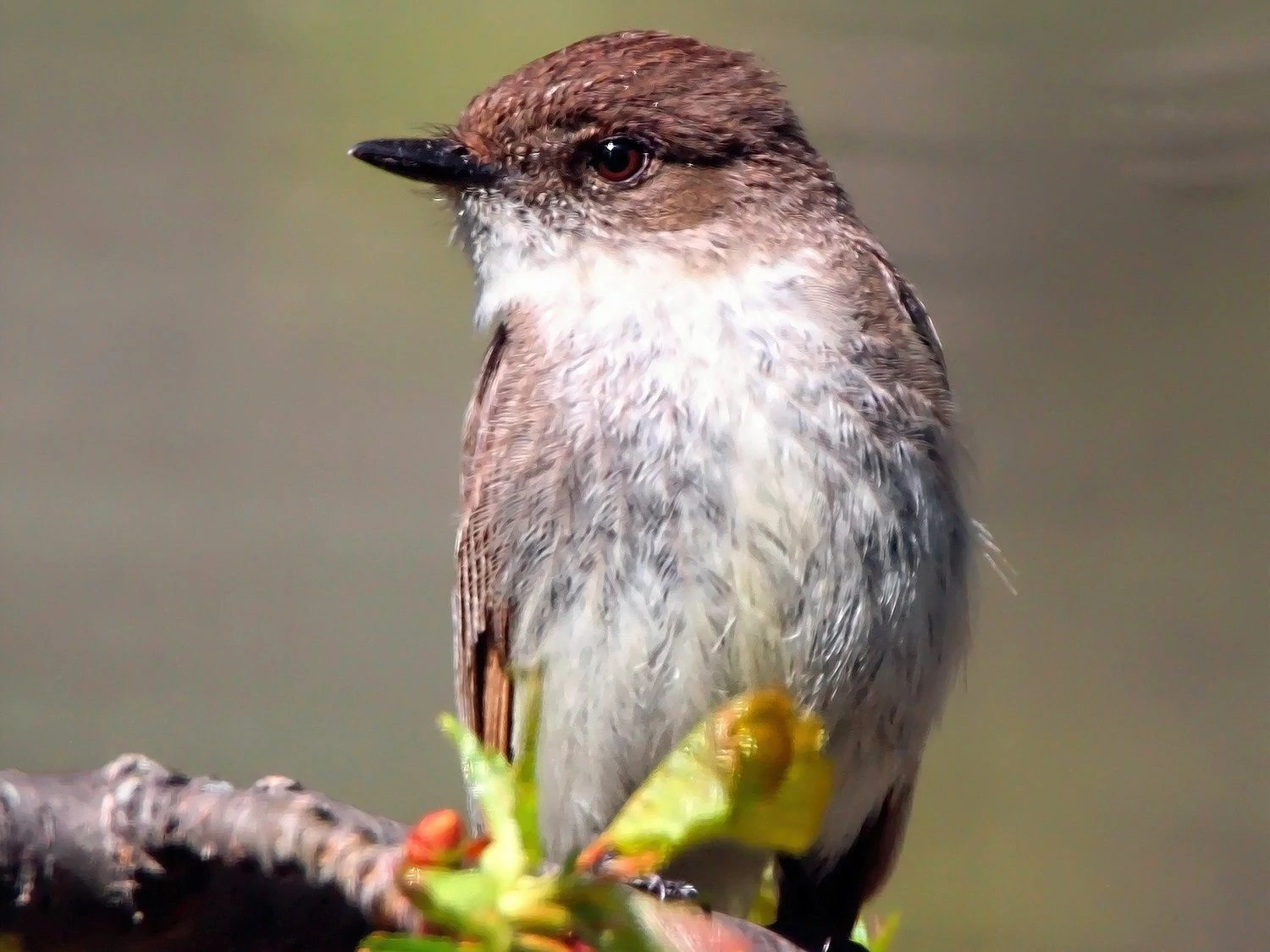
Eastern Phoebes are plump songbirds that are grayish-brown on the back and whitish underneath and with a darker head.
- Length: 5.5-6.7 in (14-17 cm)
- Weight: 0.6-0.7 oz (16-21 g)
- Wingspan: 10.2-11.0 in (26-28 cm)
Eastern Phoebes are migratory birds, breeding across northeastern and central states and into Canada before migrating to the southeast and Mexico for winter.
Some birds may remain all year towards the south of their range.
Eastern Phoebes tend to be found alone, rather than in pairs or flocks, in quiet woodland wagging their tails from low perches.
As they are flycatchers, flying insects make up the most of their diet, but they will also eat spiders and other insects, small fruit, and seeds. They often nest on bridges and barns or houses, making a nest out of mud and grass.
To attract more Eastern Phoebes to your backyard, try putting up a nest box or native plants that produce berries.
12. House Wren
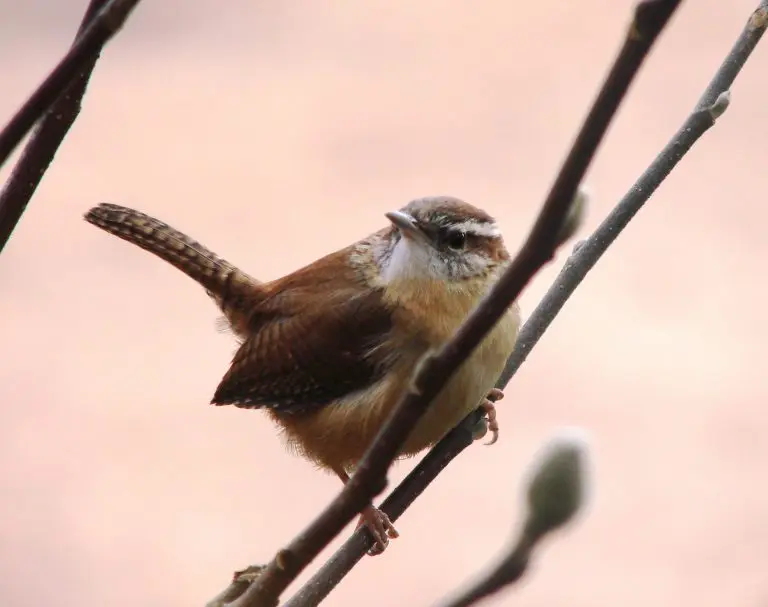
House Wrens are small nondescript brown birds with darker barred wings and tails and a paler throat.
- Length: 4.3-5.1 in (11-13 cm)
- Weight: 0.3-0.4 oz (10-12 g)
- Wingspan: 5.9 in (15 cm)
House Wrens spend their summer breeding in most states before migrating to the far south and Mexico for winter.
House Wrens can be found in backyards, parks and open woods foraging for insects and spiders.
They can often be found energetically hopping through tangles and low branches with their tails up, stopping to sing their cheerful song.
House Wrens are fierce for their size especially when it comes to getting the best nest holes, they will often harass larger birds, sometimes dragging eggs or nestlings out of a nest site they want.
You can attract more House Wrens to your backyard by leaving piles of brush or putting up a nest box.
13. House Sparrow
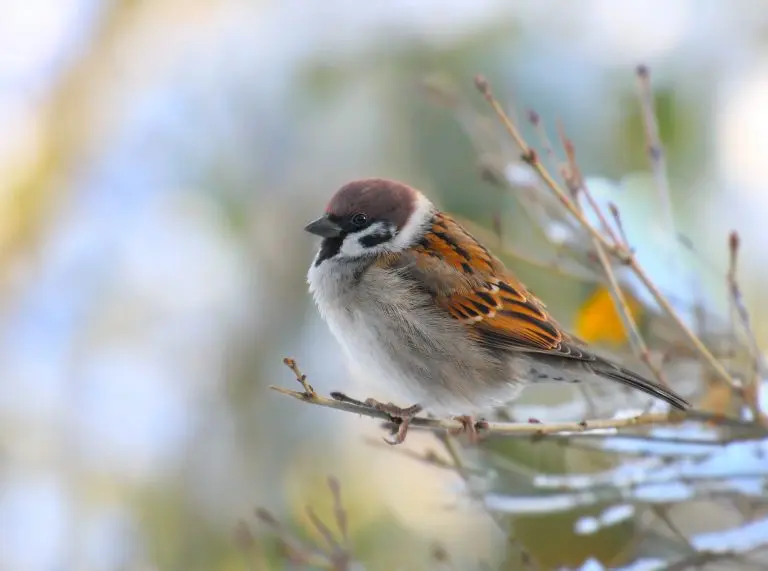
The House Sparrow is another introduced species that has done very well and is now one of the most common birds.
They are small brown-backed birds with black streaks. They have gray and brown heads and white cheeks, and a white band around the neck. Their bellies are gray.
- Length: 5.9-6.7 in (15-17 cm)
- Weight: 0.9-1.1 oz (27-30 g)
- Wingspan: 7.5-9.8 in (19-25 cm)
House Sparrows live in all US states and down into Central America.
They are found near houses and buildings and can be quite tame, so they may eat out of your hand.
They eat mostly grain and seed as well as discarded food. They can be considered a pest as they are non-native but will be found in backyards even if you do not feed them.
You can attract more House Sparrows to your backyard feeders with most kinds of birdseed, including millet, corn, and sunflower seeds.
14. Eastern Towhee
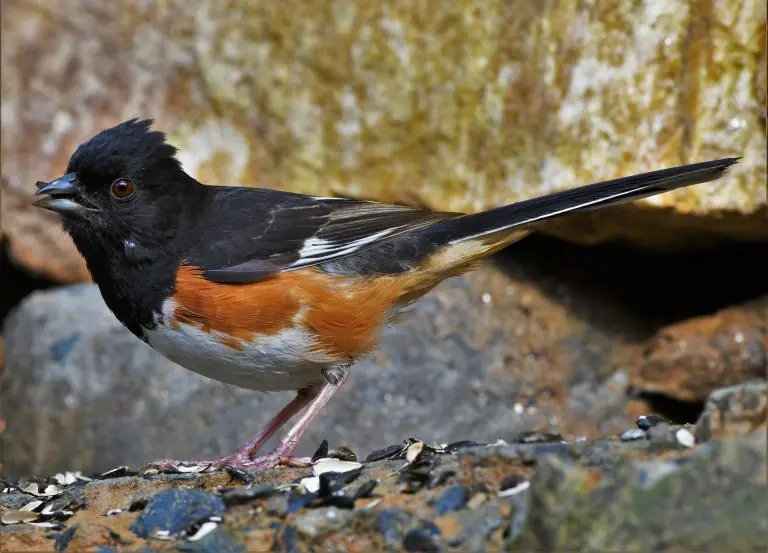
Eastern Towhees are striking large sparrows, about the size of Robin, with a black head, throat, and back, reddish sides, log tails, and a white belly in the males. The females are similar but with brown instead of black.
- Length: 6.8-8.2 in (17.3-20.8 cm)
- Weight: 1.1-1.8 oz (32-52 g)
- Wingspan: 7.9-11.0 in (20-28 cm)
Resident in southeastern states but birds further north move south for the winter and may only appear in winter on the western edge of their range.
Eastern Towhees spend their time rummaging in the undergrowth and can be found along the edges of forests and thickets.
Eastern Towhees visit feeders for fallen seed if your yard has overgrown borders and will also visit platform feeders for black oil sunflower seeds, hulled sunflower seeds, cracked corn, and millet.
15. Spotted Towhee
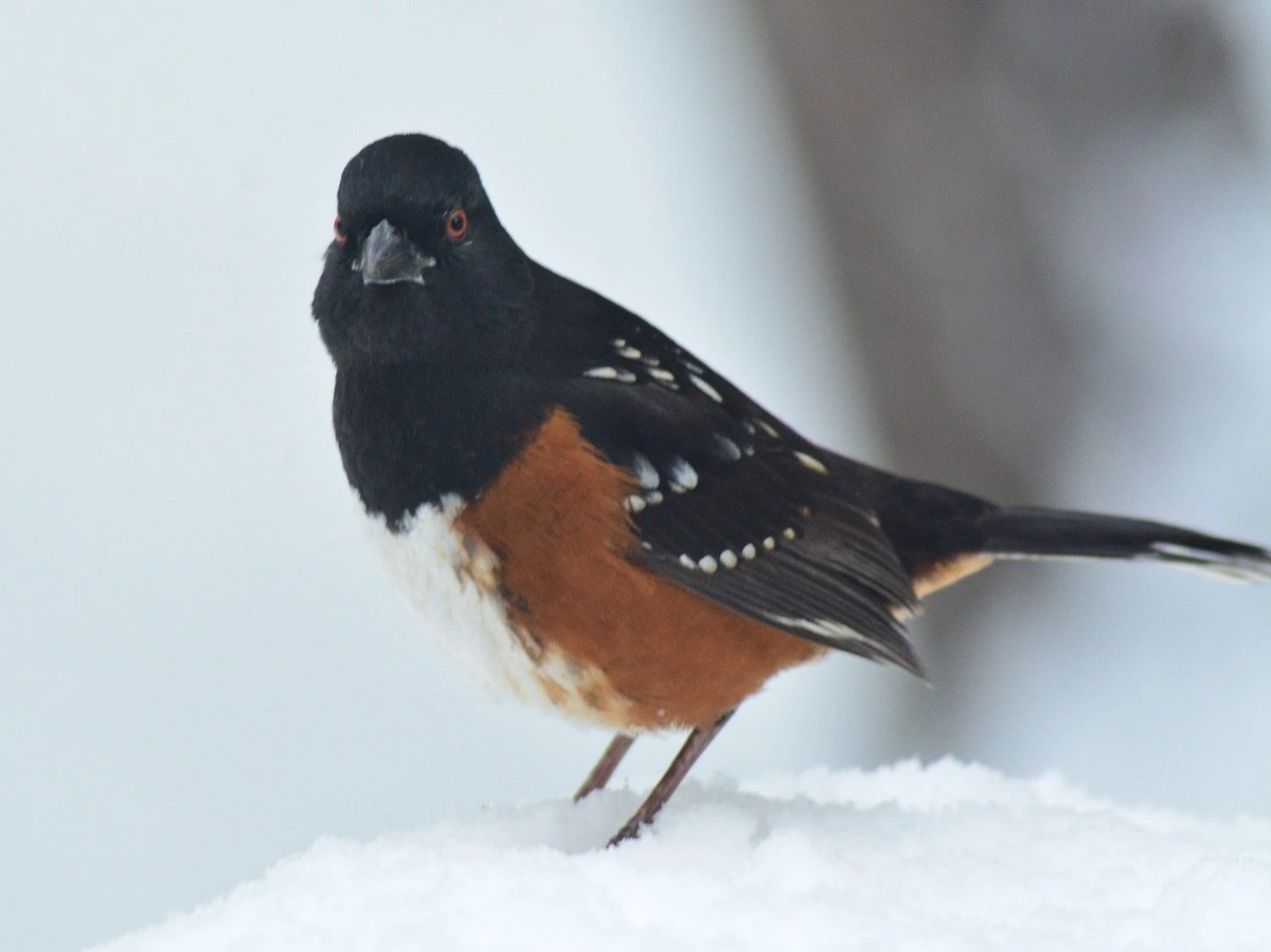
Spotted Towhees are large sparrows that are black on the head, throat, and back in the males and brown in the females. Both males and females have reddish-brown sides and white bellies, and white spots on the wings and back. They have long tails and are about the size of a Robin.
- Length: 6.7-8.3 in (17-21 cm)
- Weight: 1.2-1.7 oz (33-49 g)
- Wingspan: 11.0 in (28 cm)
They are resident on the Pacific coast but migrate from northern central states after breeding and appear in winter in a swath from north to south across all central states.
Spotted Towhees can be found on the ground in dense tangles of shrubs scratching around for insects, including beetles, crickets, grasshoppers, caterpillars, wasps, and bees. They also eat acorns, berries, and seeds.
You can attract more Spotted Towhees to your yard if you leave overgrown borders, and they will visit platform feeders or ground feeders for Black Oil Sunflower seeds, Hulled Sunflower seeds, Cracked Corn, Millet, and Milo.
16. Brown Thrasher
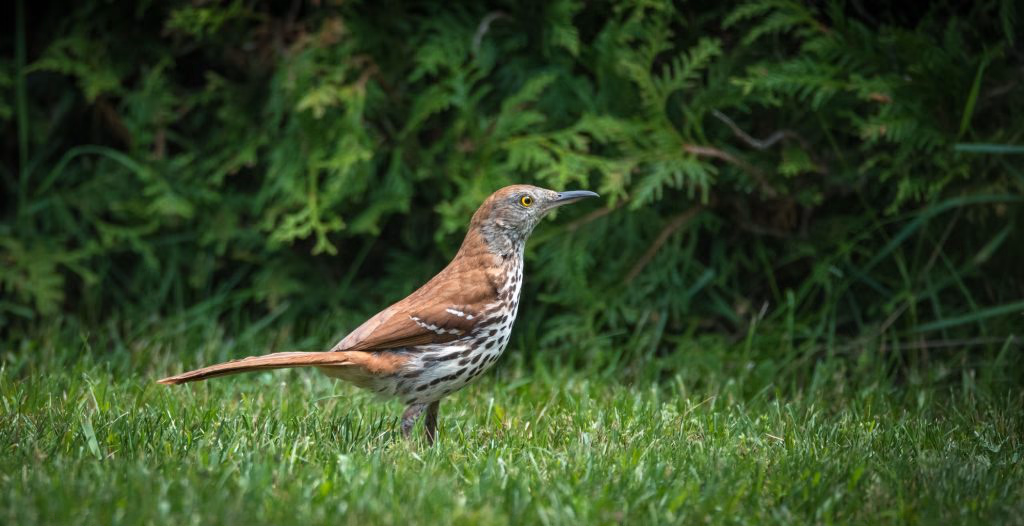
Brown Thrashers are large songbirds with long proportions. They are about the same size as a robin. They are brown on the back and with white-streaked chests and bellies. Their faces are gray with bright yellow eyes.
- Length: 9.1-11.8 in (23-30 cm)
- Weight: 2.1-3.1 oz (61-89 g)
- Wingspan: 11.4-12.6 in (29-32 cm)
Brown Thrashers live in central and eastern North America. Those birds in the southeast of their range remain all year, but birds further north migrate south for the winter.
Brown Thrashers are hard to spot for their size as they spend most of their time in thickets and shrubbery. However, they can be heard rummaging along the ground in the leaf litter and soil, looking for insects.
Brown Thrashers also eat berries, beetles, and flying insects from the air. They may come to your backyard if there is dense cover and berry shrubs and they collect fallen seed from under feeders.
Over 1000 different song types are sung by these most accomplished songbirds, which is one of the largest of any North American songbird.
17. Savannah Sparrow
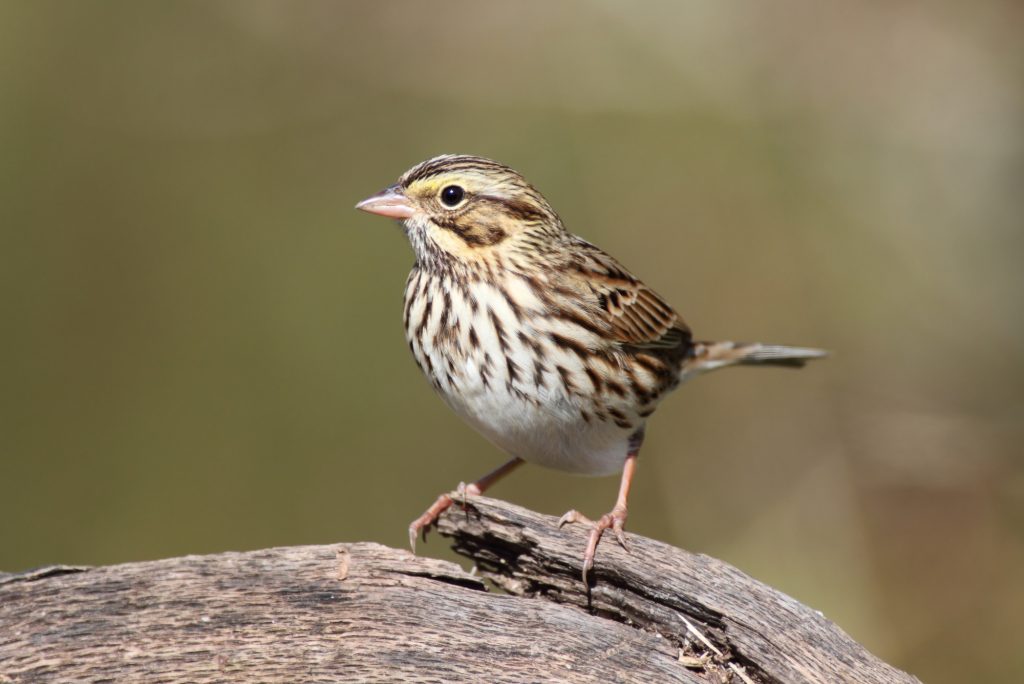
If you get a close enough look, you will see this brown sparrow has a distinctive yellow patch by the eye. They have short tails and a streaky brown coloring.
- Length: 4.3-5.9 in (11-15 cm)
- Weight: 0.5-1.0 oz (15-28 g)
- Wingspan: 7.9-8.7 in (20-22 cm)
They breed in Canada and the US before migrating to Southern States and Mexico. These birds do not regularly visit feeders, but they may visit your yard if you keep brush piles, have long grass, and live near fields.
They feed on insects and spiders in the breeding season and seeds in the winter.
18. Great-crested Flycatcher
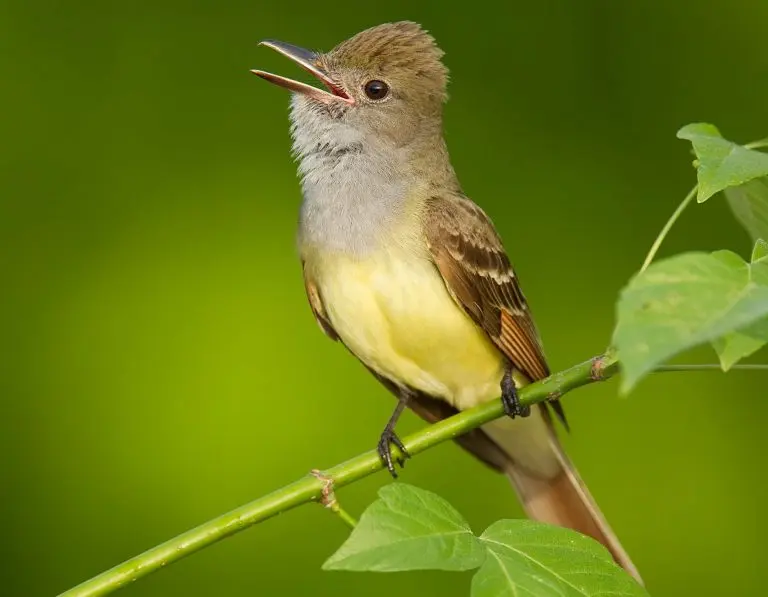
Great Crested Flycatchers are brown on the back with a yellow belly and gray throat. They have reddish flashes in the wing and tail feathers. The crest is not very obvious.
- Length: 6.7-8.3 in (17-21 cm)
- Weight: 0.9-1.4 oz (27-40 g)
- Wingspan: 13.4 in (34 cm)
Great Crested Flycatchers breed over much of Eastern North America and spend the winter in southern Florida, southern Mexico, and Central America.
They sit perched up high in woodland, waiting for large insects flying, such as butterflies, grasshoppers, moths, wasps, and spiders. They can be found in mixed woodlands and at the edges of clearings, parks, and tree-lined neighborhoods or perched on fenceposts or other man-made structures. They will also eat berries and small fruit.
To attract more Great Crested Flycatchers to your backyard, try planting native species of plants and leaving brush piles to attract insects. plant berry-producing plants and put up a nest box as they readily take up residence in them.
19. Field Sparrow
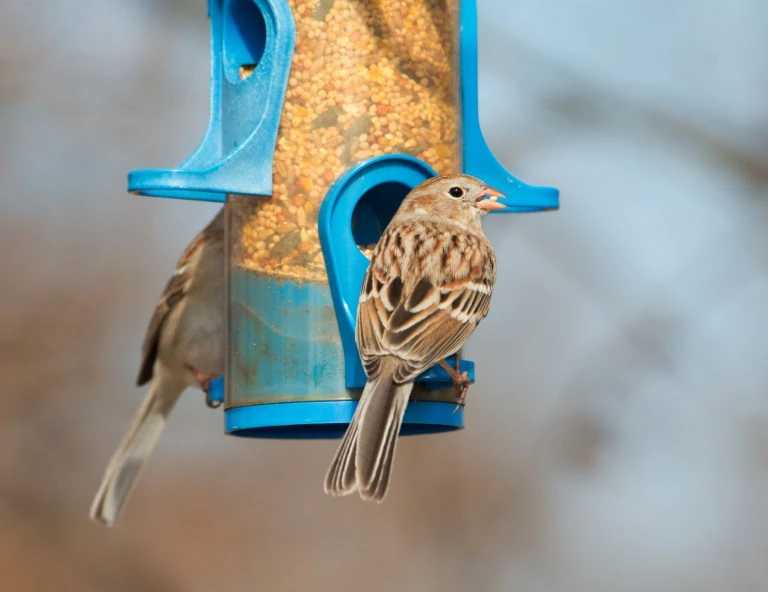
Field Sparrows are small, slender brown-backed birds streaked with black. Their undersides are gray, as are their heads, and they have a reddish crown and pink bill.
- Length: 4.7-5.9 in (12-15 cm)
- Weight: 0.4-0.5 oz (11-15 g)
- Wingspan: 7.9 in (20 cm)
Field Sparrows remain all year in the east, but those that breed in the Mid-West head south for winter.
They quietly feed on weeds and seeds and can be easily missed as they prefer abandoned fields and are shy. In the breeding season, the males will sing from a perch in the early mornings, and so they are easier to spot.
20. Bewick’s Wren
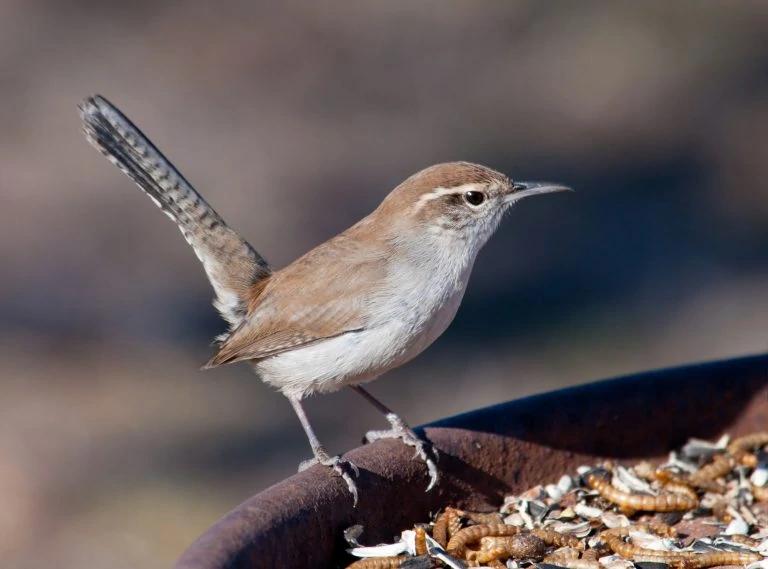
Bewick’s Wrens are brown-backed birds with long upright tails. They have gray bellies and a white stripe over the eye.
- Length: 5.1 in (13 cm)
- Weight: 0.3-0.4 oz (8-12 g)
Bewick’s Wrens live in southern and western states all year with some small movements in winter.
You can find them in scrub, thickets, and open woodland, hopping from branch to branch, flicking their long tails.
They feed on insects and larvae and may visit backyard feeders for suet, mealworms, and hulled sunflower seeds.
21. Pine Siskin
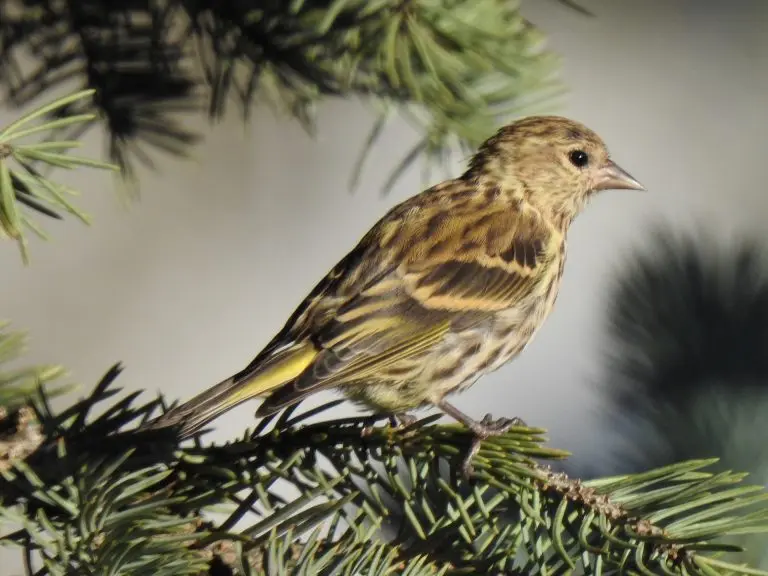
Pine Siskins are small brown finches with yellow streaks in the wing and tail. They have a forked tail and pointed wings, with a short pointed bill.
- Length: 4.3-5.5 in (11-14 cm)
- Weight: 0.4-0.6 oz (12-18 g)
- Wingspan: 7.1-8.7 in (18-22 cm)
Pine Siskins remain all year in the pine forests in the western states and along the Canadian Border. Some also breed in Canada before heading south for winter.
Depending on pine cone crops, they can be found over much of North America. As their name suggests, Pine Siskins predominantly eat seeds from conifers, but they also eat young buds and seeds from grasses and weeds.
Pine Siskins can be attracted to backyards with thistle and nyjer feeders but also black oil sunflower seeds and suet.
22. Hermit Thrush
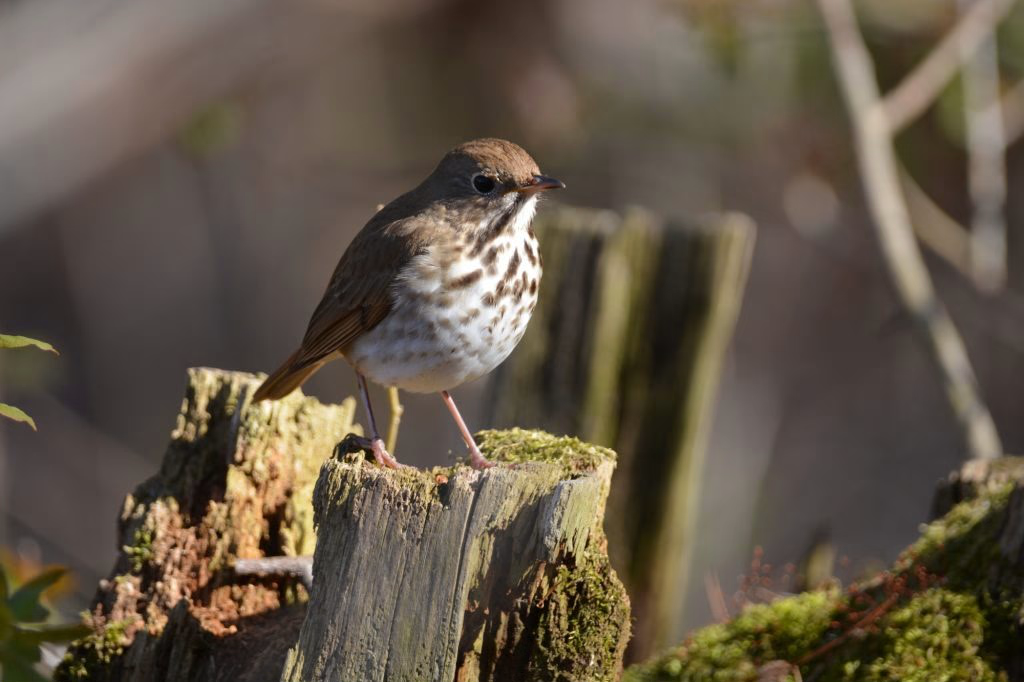
Hermit Thrushes are birds that stand to attention, with an upright manner and chunky body, and long tails. They are brown on the back and white underneath, with spots on the throat and breast.
- Length: 5.5-7.1 in (14-18 cm)
- Weight: 0.8-1.3 oz (23-37 g)
- Wingspan: 9.8-11.4 in (25-29 cm)
Hermit Thrush breed in Canada, northeast US states, and the western US. They can be seen during migration in central states before they spend the winter along the Pacific Coast, southeast states, and Mexico.
Hermit Thrush forages on the ground in forest clearings in the leaf litter, looking for insects. In winter, they also eat berries.
They rarely visit backyards, but their somewhat forlorn song can be heard in spring and summer.
23. Swamp sparrow
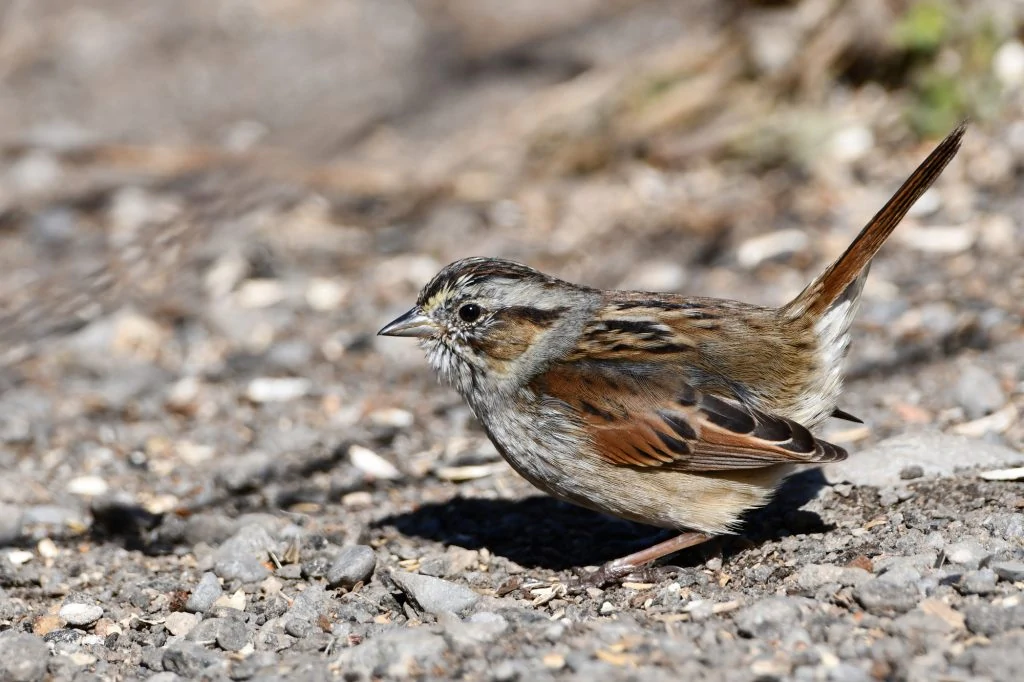
Swamp Sparrows are dark brown on the back with rusty crowns and wings. They have gray breasts and white throats. Their heads are gray and brown faces with a dark eye line and yellow end to the beak.
- Length: 4.7-5.9 in (12-15 cm)
- Weight: 0.5-0.8 oz (15-23 g)
- Wingspan: 7.1-7.5 in (18-19 cm)
Swamp Sparrows breed in Canada and Northeastern and North Central US states before migrating to Eastern and Southern US states and Mexico.
As the name would suggest, Swamp Sparrows are found in wetlands, swamps, bogs, and coastal marshes. They feed on seeds and fruit, especially in winter, and insects in spring.
They do not visit backyards except in migration to yards with lots of vegetation and water.
24. Brown Creeper
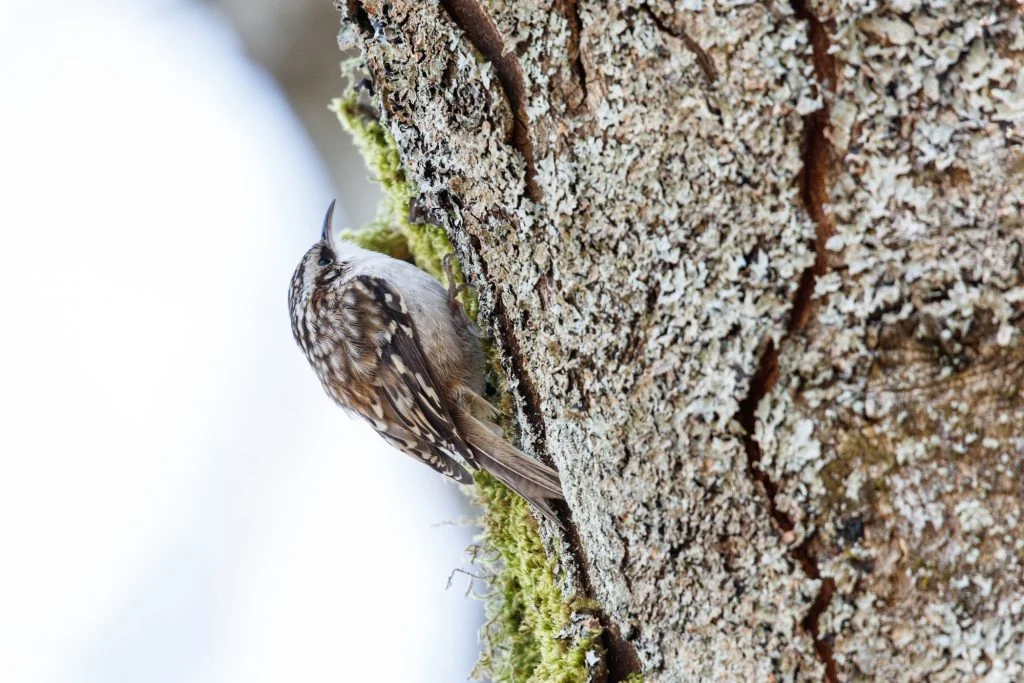
Brown Creepers are tiny songbirds that are hard to spot against tree trunks, with their streaked brown backs and white undersides.
- Length: 4.7-5.5 in (12-14 cm)
- Weight: 0.2-0.3 oz (5-10 g)
- Wingspan: 6.7-7.9 in (17-20 cm)
Brown Creepers do not migrate, but they can move south and from higher elevations in winter. They can be found in Alaska, Southern Canada, Northeastern and Eastern US states, and down to Mexico and Central America. They also move into central and southeastern states in some winters.
To spot one of these tiny birds, look closely at tree trunks of mature woodland with large trees where you may find them hunting for insects and larvae hidden in the bark. They are usually found working their way up the tree and so face upwards, unlike nuthatches which face down the tree trunk.
Rather than singing, these songbirds make a high piercing call that helps locate them.
25. Rose-breasted Grosbeak – Female
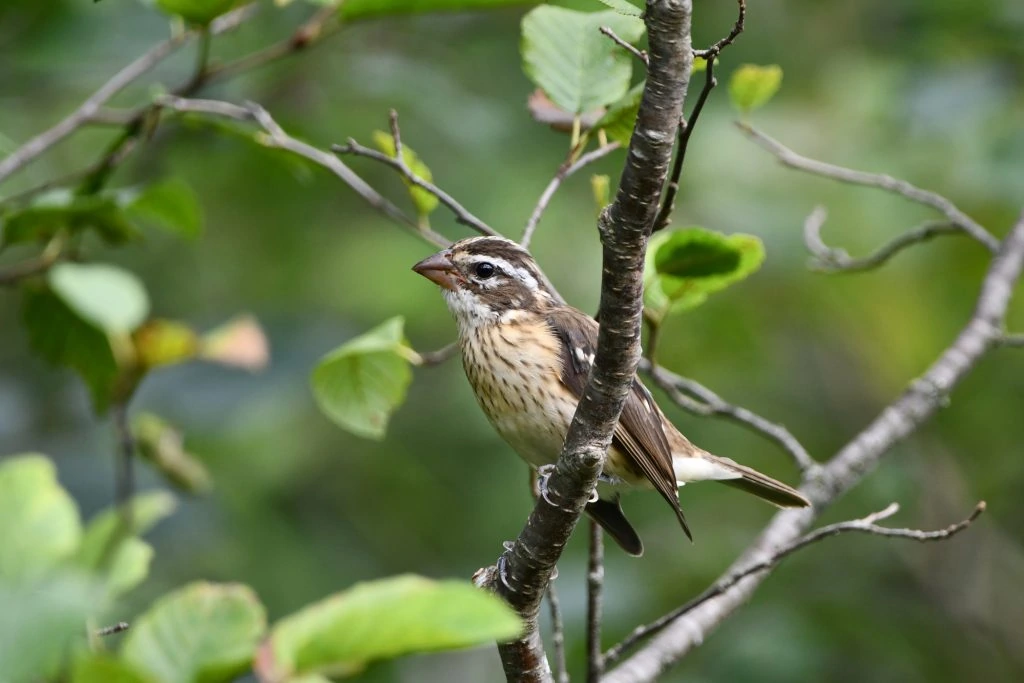
Female Rose-breasted Grosbeaks and immature males are brown with lots of streaking and a flash of yellow under the wings.
Rose-breasted Grosbeaks males are black-and-white birds with black heads and back and white bellies with a red breast. They also have a flash of red under the wings.
- Length: 7.1-8.3 in (18-21 cm)
- Weight: 1.4-1.7 oz (39-49 g)
- Wingspan: 11.4-13.0 in (29-33 cm)
Rose-breasted Grosbeaks breed in northeastern US states, the Midwest, and southern and central Canada. They can be seen during migration in the southeast. Winter is spent in Mexico, Central America, and the Caribbean.
Try putting out sunflower seeds and peanuts to attract more Rose-breasted Grosbeaks to your backyard.
26. Purple Finch – Female
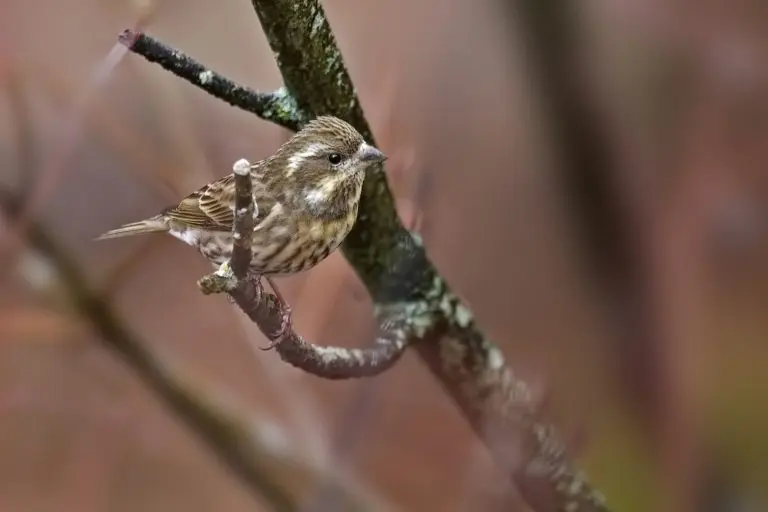
Female Purple Finches are brown-streaked birds. Males have reddish-purple heads and breasts. They look similar to House Finch with the reddish-purple head and breast with more brown on the back and wings.
- Length: 4.7-6.3 in (12-16 cm)
- Weight: 0.6-1.1 oz (18-32 g)
- Wingspan: 8.7-10.2 in (22-26 cm)
They breed in Canada and overwinter in eastern states but can be found all year in the north-east are Pacific coast.
You can spot them in evergreen forests feeding on seeds and buds, nectar, and berries. They readily come to feeders for black oil sunflower seeds.
27. Wood Thrush
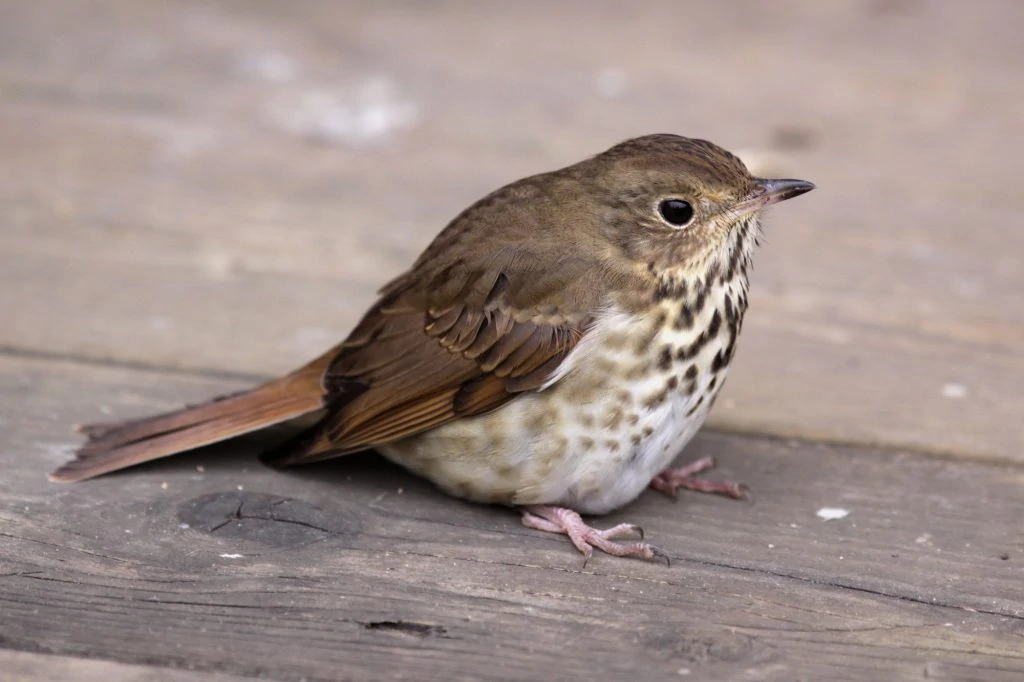
Wood Thrushes plump white and black-spotted bellies give them a slightly comical appearance. They are brown on the back and have reddish colors on the crown and upper back.
- Length: 7.5-8.3 in (19-21 cm)
- Weight: 1.4-1.8 oz (40-50 g)
- Wingspan: 11.8-13.4 in (30-34 cm)
Wood Thrushes migrate from Eastern US states across the Gulf of Mexico into Central America in one night.
These birds stay hidden foraging in leaf litter for insects, such as beetles and flies, in mature forests. They can be heard in spring making a ‘flute-like’ song.
28. California Towhee
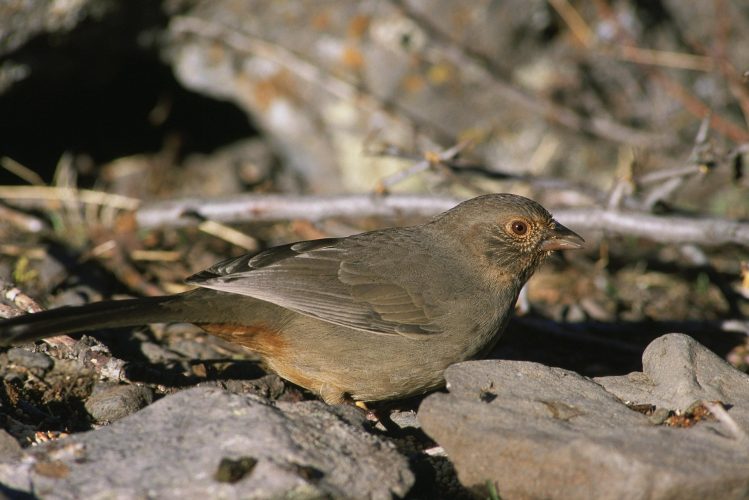
California Towhees are large, brown, plump sparrows with long tails, short wings, and a rusty patch under the tail.
- Length: 8.3-9.8 in (21-25 cm)
- Weight: 1.3-2.4 oz (37-67 g)
- Wingspan: 11.4 in (29 cm)
They are found in the coastal chaparral scrub areas of California, Oregon, and Baja California. They will also visit backyards and sit on fenceposts, and chase their reflections in car mirrors or windows.
California Towhees’ diet is mostly seeds from grasses and herbs, but they also eat berries such as elderberry, coffeeberry, and acorns.
To attract more Califonia Towhees to your yard, try millet on-ground feeders and plant native berry plants.
29. American Tree Sparrow
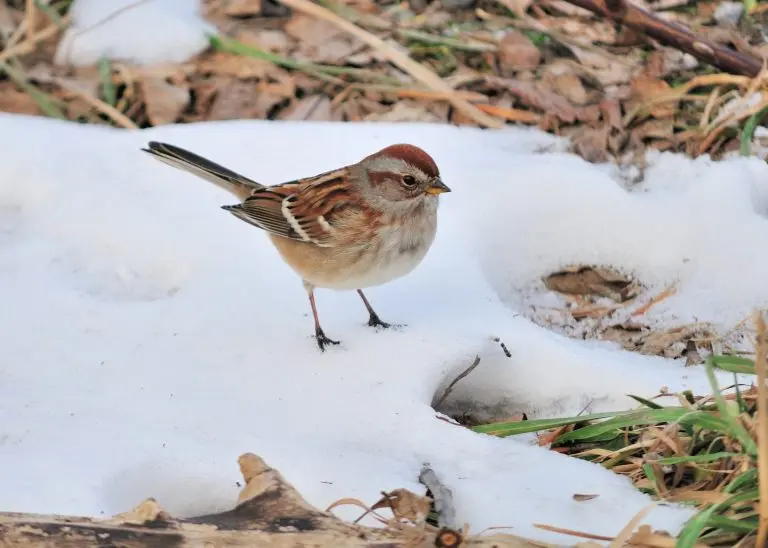
American Tree sparrows are long-tailed brown-streaked plump birds with rusty caps, gray faces, and a rusty eyeliner.
- Length: 5.5 in (14 cm)
- Weight: 0.5-1.0 oz (13-28 g)
- Wingspan: 9.4 in (24 cm)
American Tree Sparrows are a bird of winter in the US and a bird of summer in Canada.
They breed in the far north of Canada and in Alaska and migrate to most US states for the winter, except the Pacific Coast and Gulf Coast.
They forage in small flocks in weedy fields and under bird feeders.
You can attract more American Tree Sparrows to your backyard platform feeders with black oil sunflower seeds, nyjer, cracked corn, and millet. They also feed off the ground under tube feeders foraging for seeds dropped or discarded from above.
30. Marsh Wren
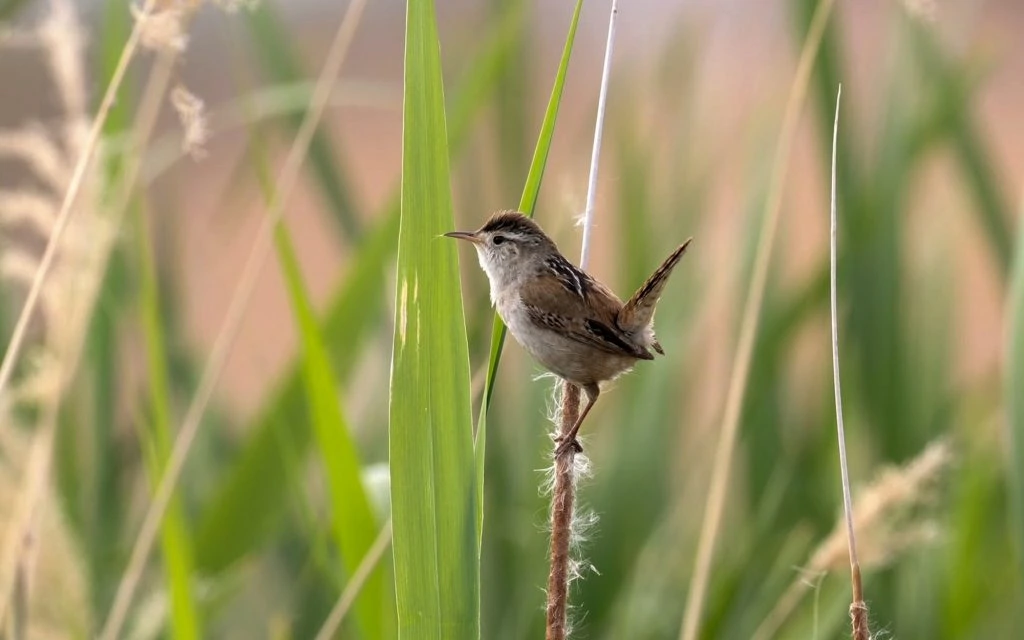
Marsh Wrens are brown with black and white streaks on its back. Their underside is grayish brown and they have the distinctive upright tail of the wren.
- Length: 3.9-5.5 in (10-14 cm)
- Weight: 0.3-0.5 oz (9-14 g)
- Wingspan: 5.9 in (15 cm)
Marsh Wrens breed in the Northern US states and Central Canada before migrating to Southern states and Mexico. Some birds in the west and along the Atlantic Coast may remain resident all year. They can be spotted during migration in the Eastern US.
Wetlands with reeds are the best place to find Marsh Wrens. They can be found clinging to reeds with each foot grabbing a different stalk. They can be hard to spot but listen out for singing amounst the reeds, especially at dawn and dusk.
31. Chestnut-backed Chickadee
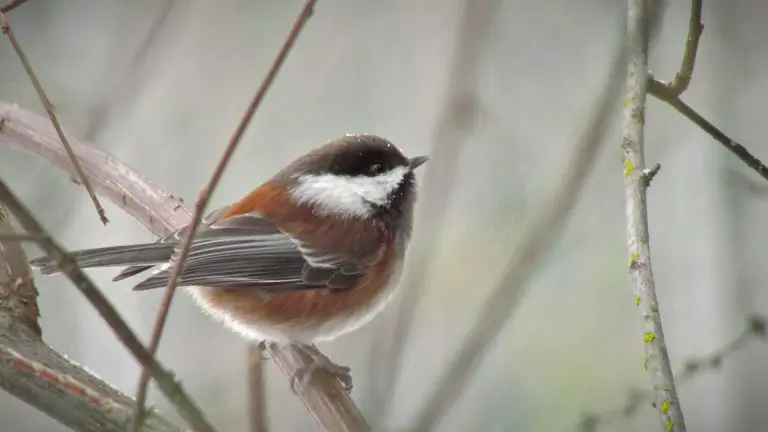
Chestnut-backed Chickadees are tiny birds with black and white on their heads, rich chestnut brown on the back, and gray wings and belly.
- Length: 3.9-4.7 in (10-12 cm)
- Weight: 0.3-0.4 oz (7-12 g)
- Wingspan: 7.5 in (19 cm)
They live flocks in wet evergreen forests along the Pacific Northwest Coast and are regular visitors to backyard feeders.
Insects including caterpillars, spiders, wasps, and aphids make up most of their diet, with seeds, berries, and fruit making up the rest.
You can attract Chestnut-backed Chickadees to your yard with black-oil sunflower seeds, suet, nyjer, peanuts, or mealworms in tube feeders, platform feeders, or suet cages. They will also use nest boxes.
32. Swainson’s Thrush
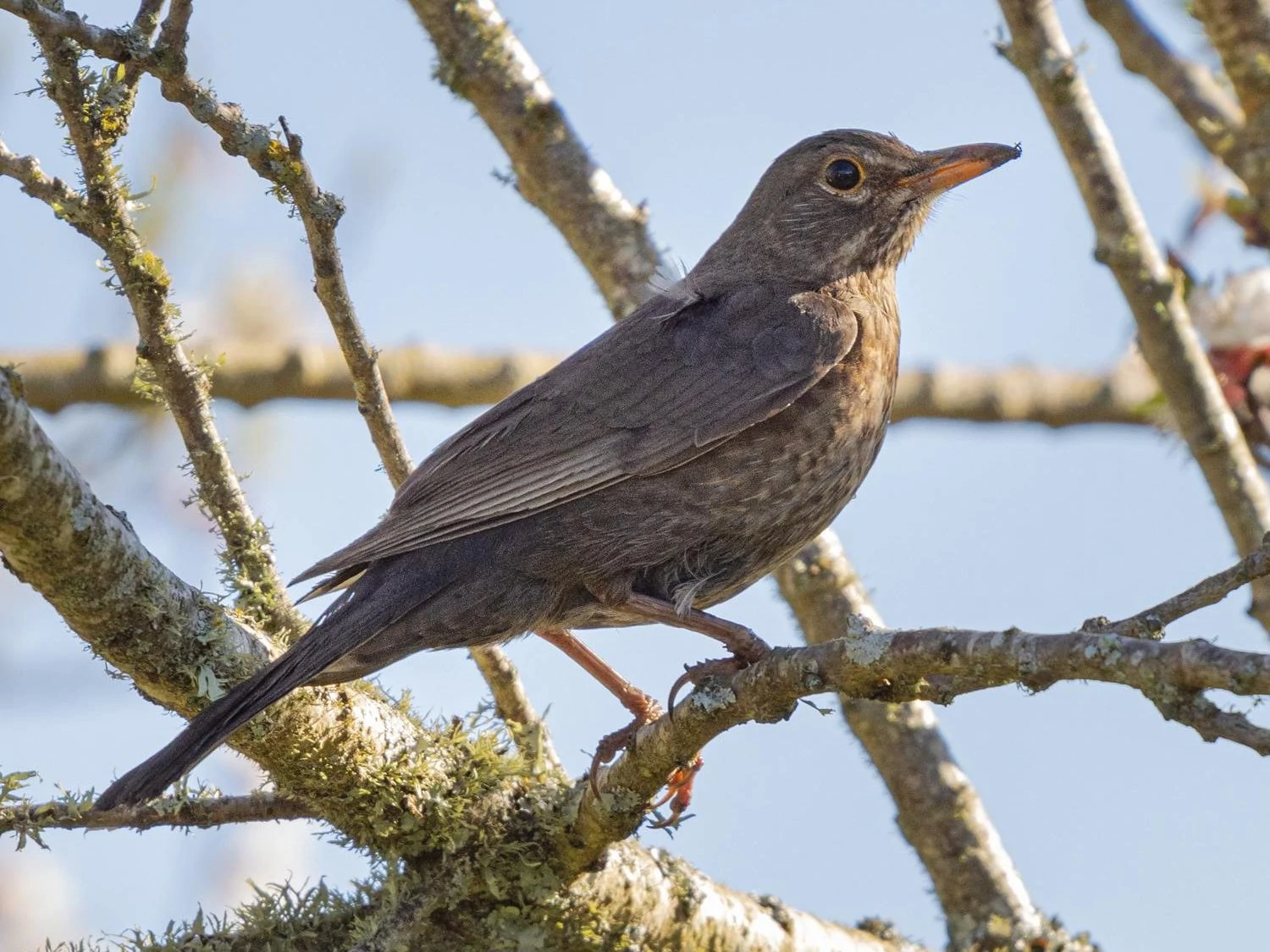
Swainson’s Thrushes are brown on the back and paler undersides that are spotted brown on the throat and breast. The spotting gets lighter the further down their flanks. Thry are medium sized and have distinctive eyerings if you are close enough t spot them.
- Length: 6.3-7.5 in (16-19 cm)
- Weight: 0.8-1.6 oz (23-45 g)
- Wingspan: 11.4-12.2 in (29-31 cm)
Swainson’s Thrushes breed in Canada, Alaska and some Northeastern and Northwestern states. They can be seen during migration over the rest of the US when they are heading to or from wintering grounds in Central and South America.
They can be found in mainly coniferous forests in breeding grounds but during migration Swainson’s Thrushes are found in areas of dense undergrowth. They feed on insects and fruit.
33. Golden-crowned Sparrow
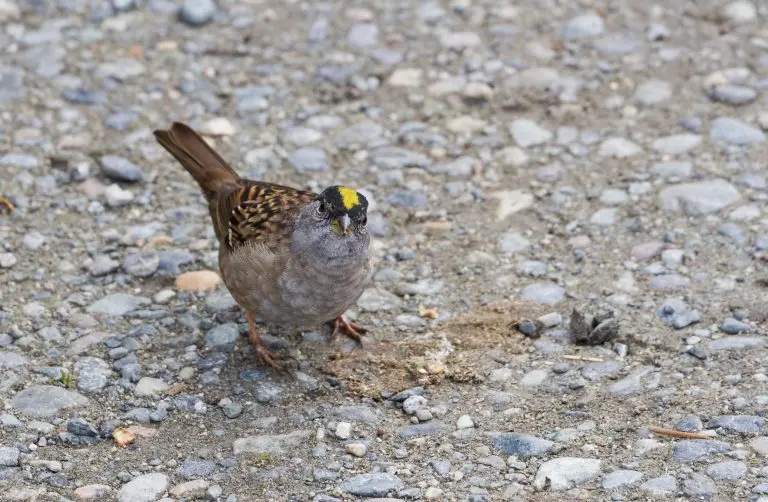
Golden-crowned Sparrows are grayish-brown underneath and streaked brown on the back. Their heads have a black crown and a bright-yellow forehead.
In winter, the colors are duller with brown on the crown, and the yellow forehead is also duller.
- Length: 5.9-7.1 in (15-18 cm)
- Weight: 1.1-1.2 oz (30-33 g)
Golden-crowned Sparrows breed in Alaska and Western Canada before migrating to the West Coast for winter.
In winter, they can be found in weedy fields scratching for seeds such as dock, sumac, and geranium.
They also eat fruit such as apples, grapes, elderberry, and olives. Insects also make up some of their diets, such as ants, beetles, butterflies, and termites.
You can attract more Golden-crowned Sparrows to your backyard with seeds in ground feeders or plant native plants that fruit.
Check out these articles if you want to know more about birds in North America:
- Backyard Birds in Every State – Free Picture ID Printable
- Hummingbirds in North America
- Birds with Red Heads
Most Common Brown Birds
These are the brown birds in order that they are spotted in checklist submitted by bird watchers
- Mourning Dove 35.6%
- American Robin 34.2%
- Song Sparrow 25.8%
- Female House Finch 24.2%
- Northern Flicker 17.6%
- Carolina Wren 17.2%
- White-throated Sparrow 11%
- Chipping Sparrow 10.8%
- Female Brown-headed Cowbird 10.5%
- Common Yellowthroat 9.9%
- Eastern Phoebe 9.4%
- House Wren 8%
- House Sparrow 8%
- Eastern Towhee 7.6%
- Spotted Towhee 5.5%
- Brown Thrasher 4.9%
- Savannah Sparrow 4.5%
- Great-crested Flycatcher 4.4%
- Field Sparrow 4.1%
- Bewick’s Wren 4%
- Pine Siskin 4%
- Hermit Thrush 3.8%
- Swamp sparrow 3.5%
- Brown Creeper 3.1%
- Rose-breasted Grosbeak – Female 3%
- Female Purple Finch 2.9%
- Wood Thrush 2.8%
- California Towhee 2.7%
- American Tree Sparrow 2.5%
- Marsh Wren 2.4%
- Chestnut-backed Chickadee 2.3%
- Swainson’s Thrush 2.3%
- Golden-crowned Sparrow 2.2%
How to Identify Birds
Here are some tips to help you identify birds so wherever you are birding, you have the knowledge to document and find the bird in a guide:
- Size – Size is the easiest thing to notice about a bird. Birds are often measured in inches or centimeters in guide books. It’s best to take a note of the bird in terms of small, medium, or large to be able to look for it later. A small bird is about the size of a sparrow, a medium bird is about the size of a pigeon and a large bird is the size of a goose.
- Shape – Take note of the silhouette of the bird and jot it down or draw the outline. Look at tail length, bill shape, wing shape, and overall body shape.
- Color pattern – Take a note of the main color of the head, back, belly, and wings, and tail for the main color and then any secondary colors or patterns. Also take note of any patterns such as banding, spots, or highlights.
- Behavior – Are they on the ground or high up in the trees. Are they in flocks or on their own? Can you spot what they are eating?
- Habitat – Woodlands, parks, shrubs, grasslands or meadows, shore or marsh.
- Use a bird identification app such as those created by ebird or Audubon

